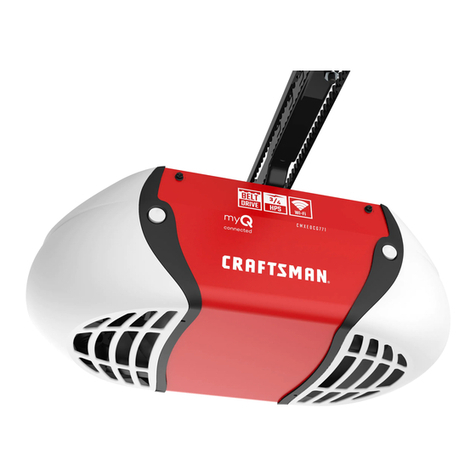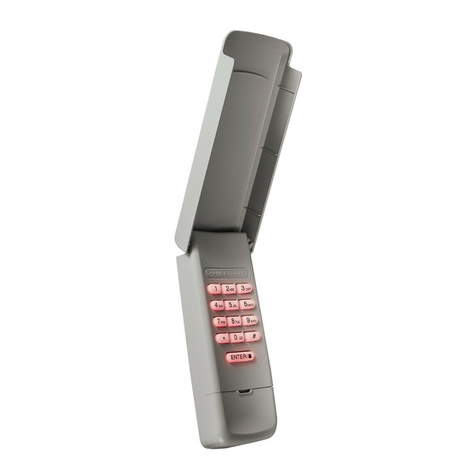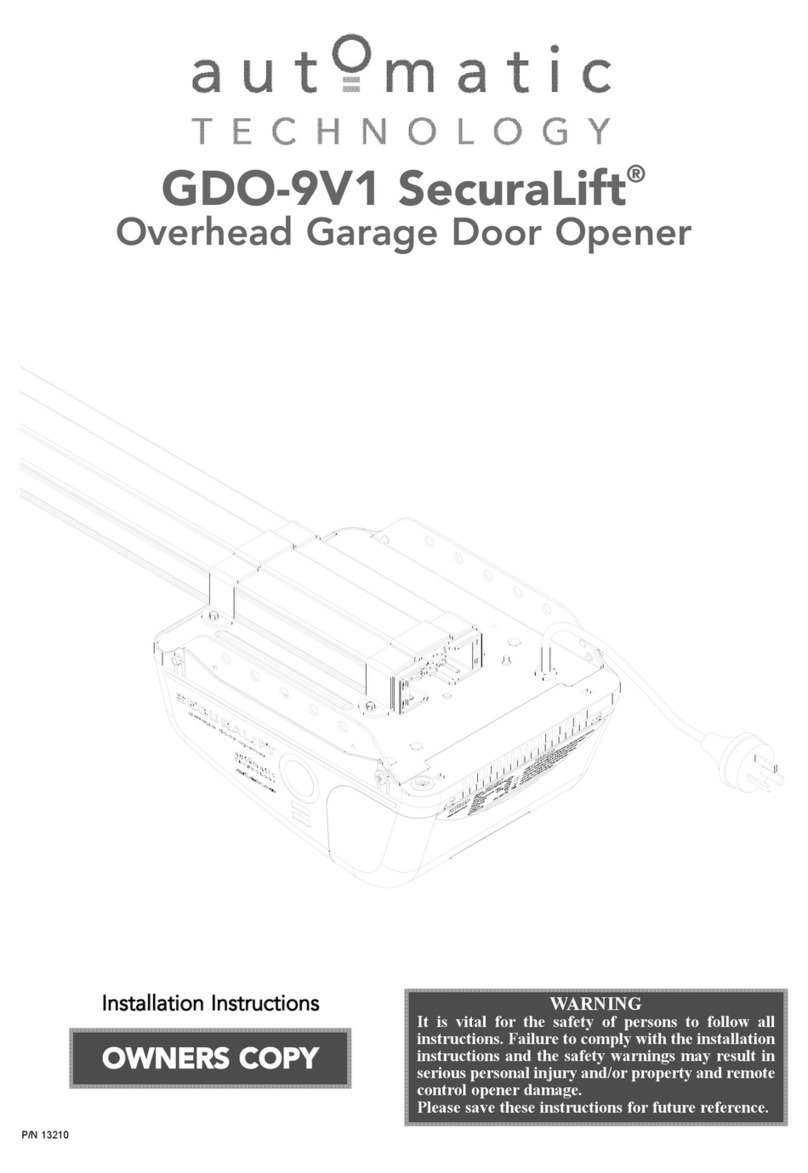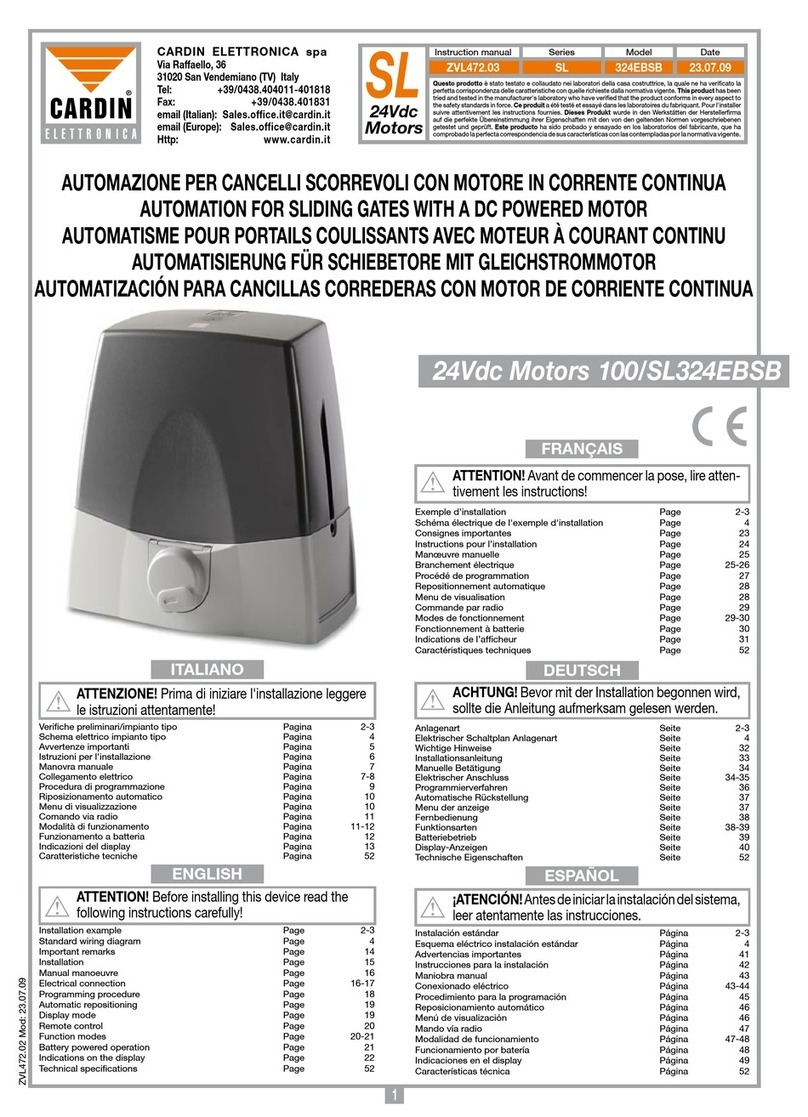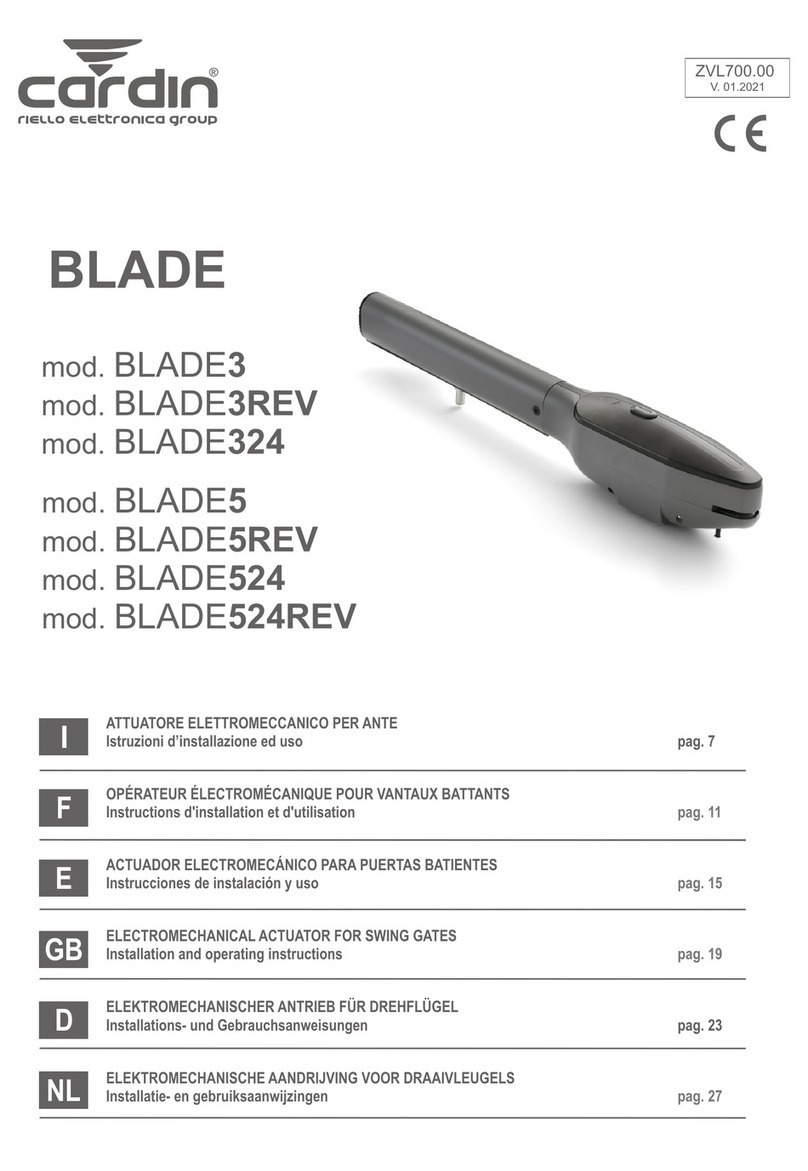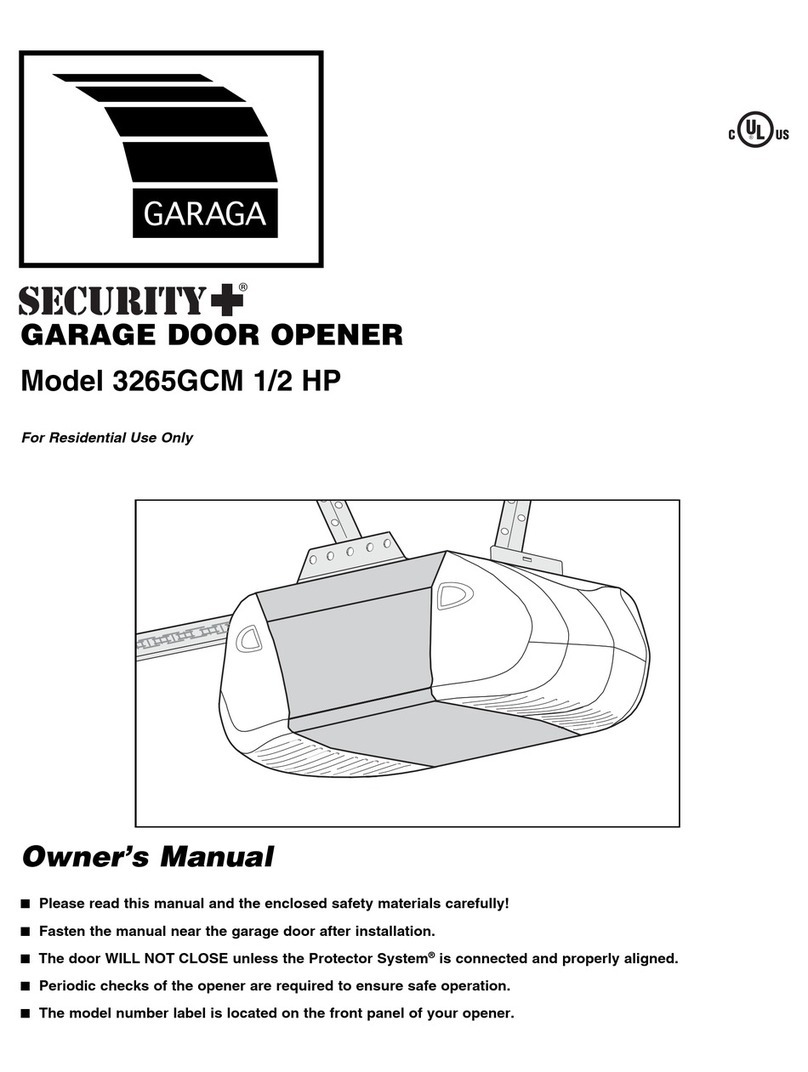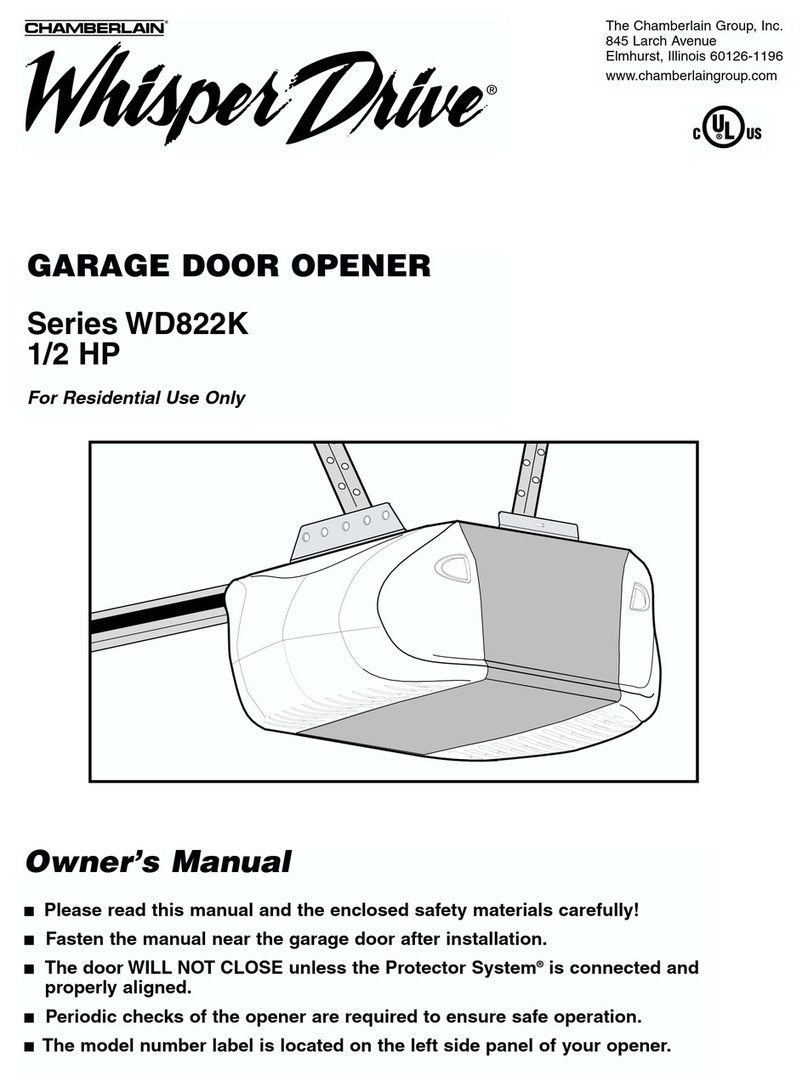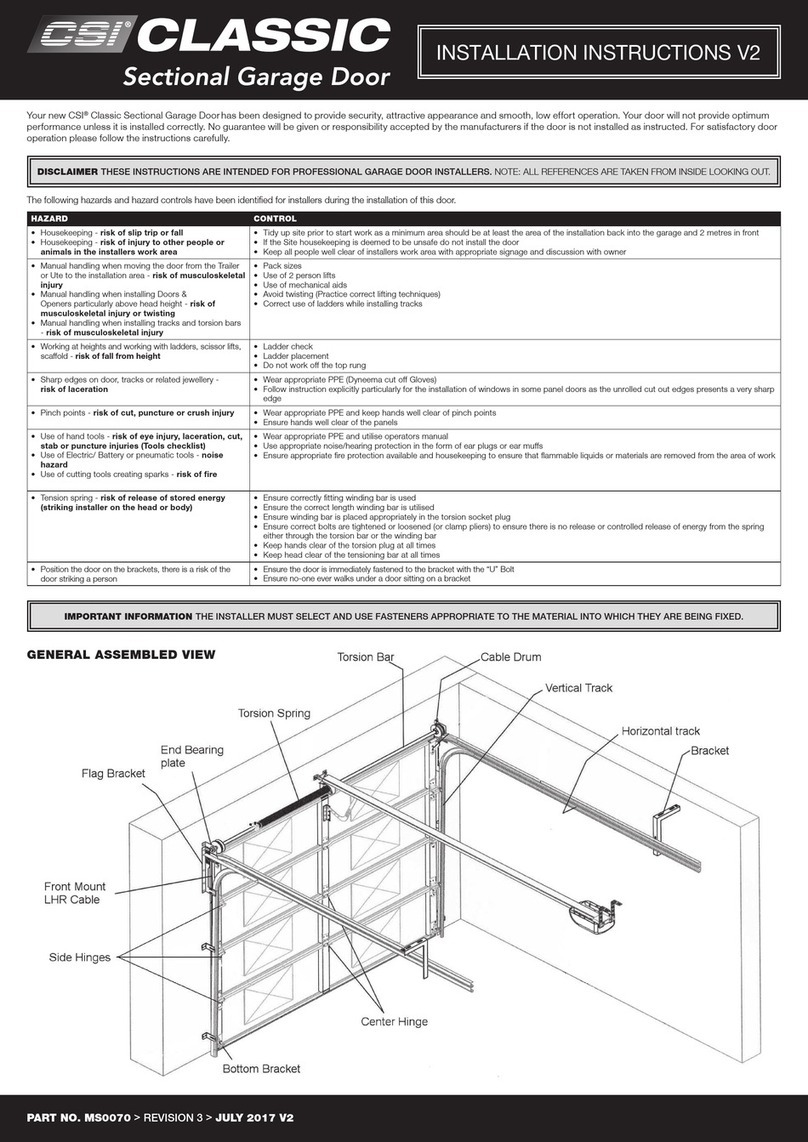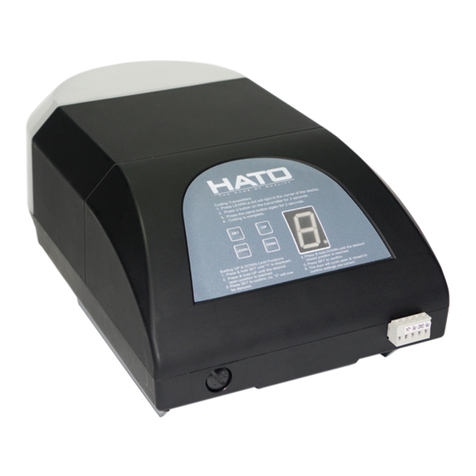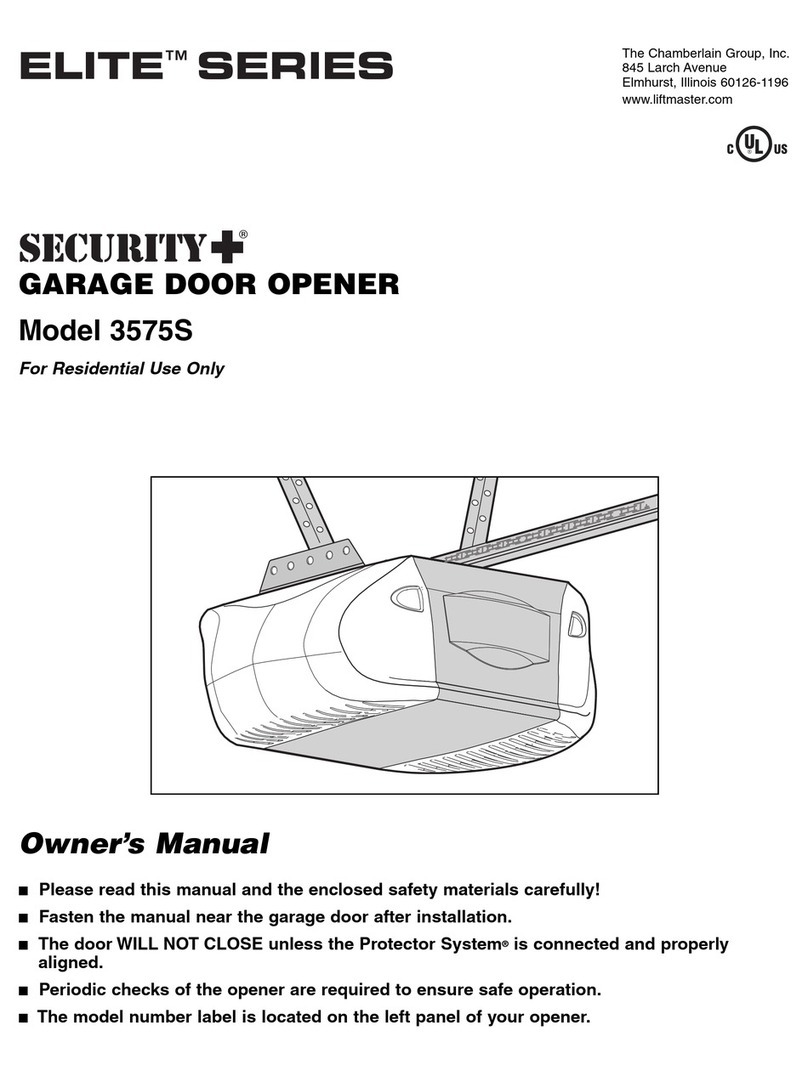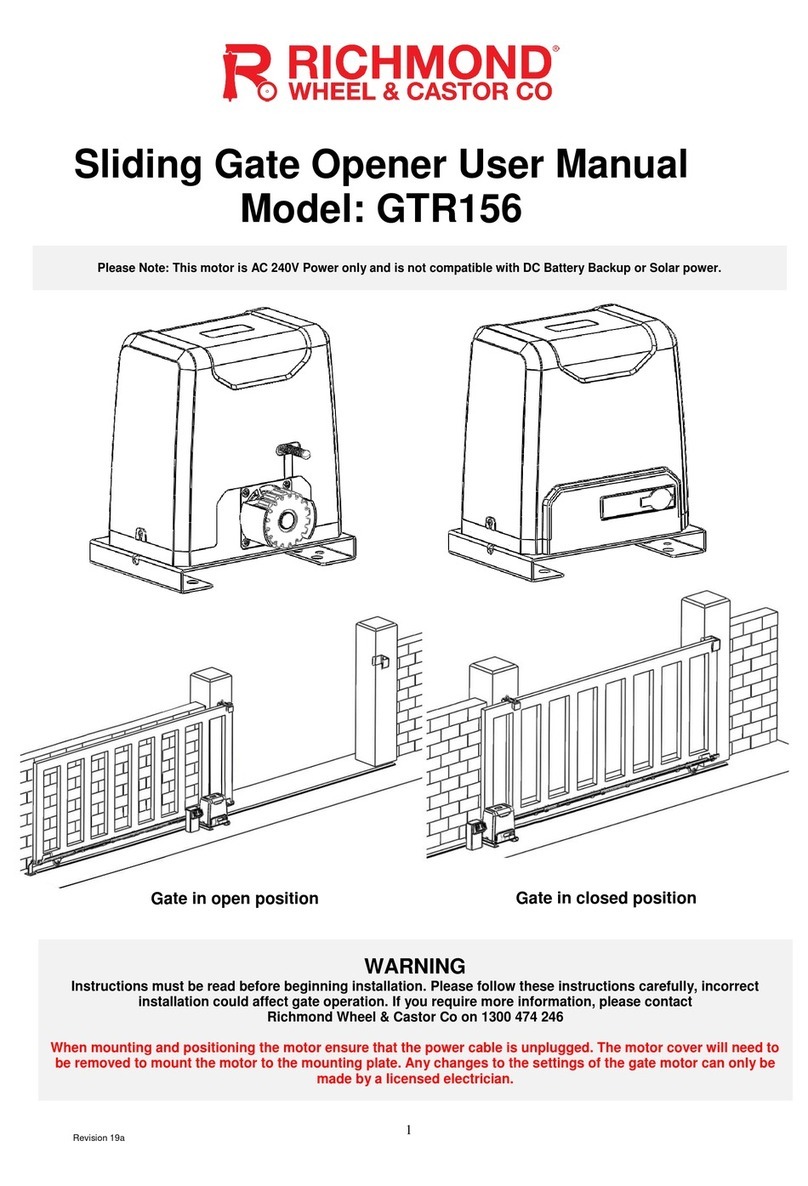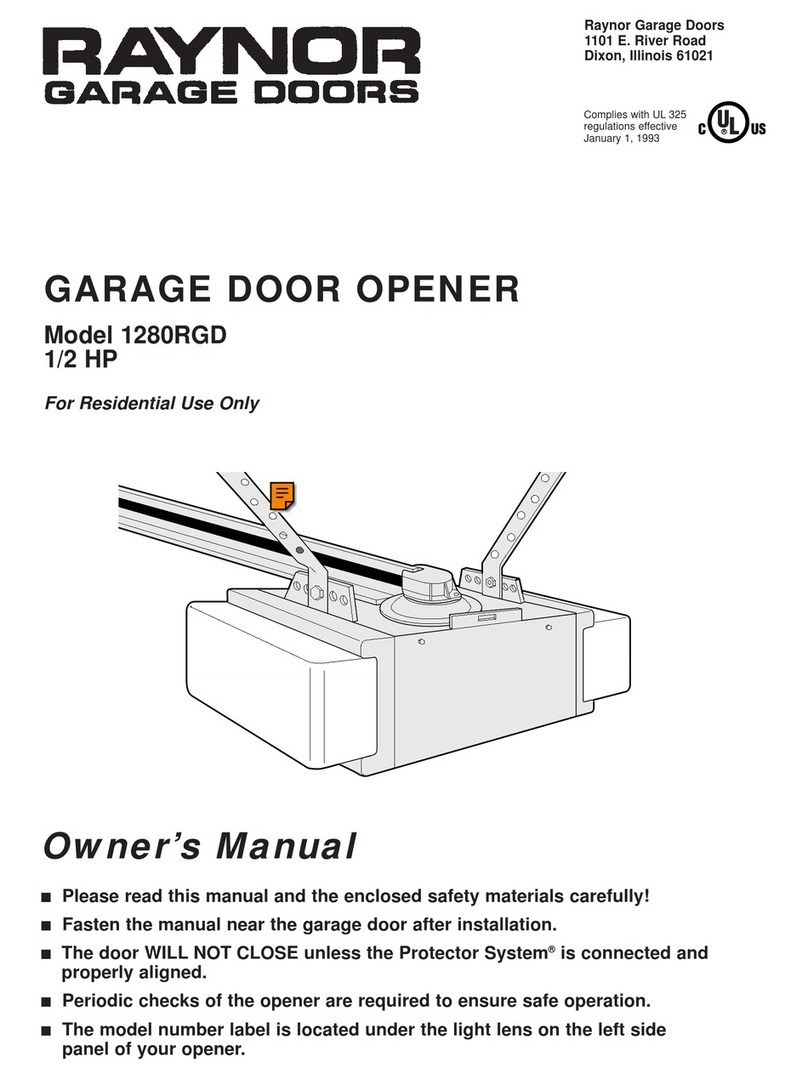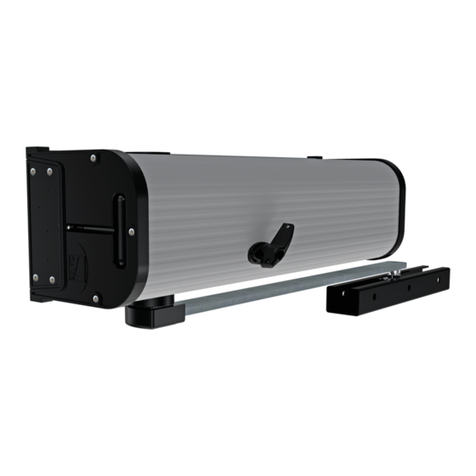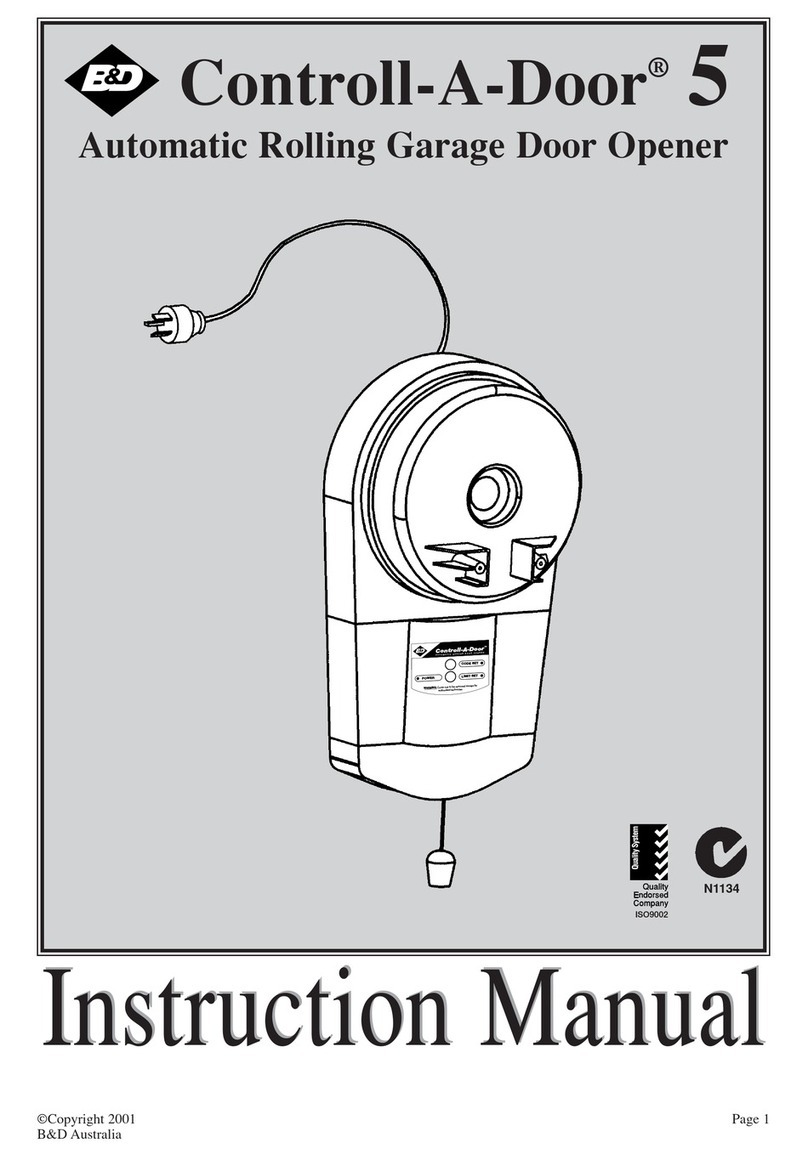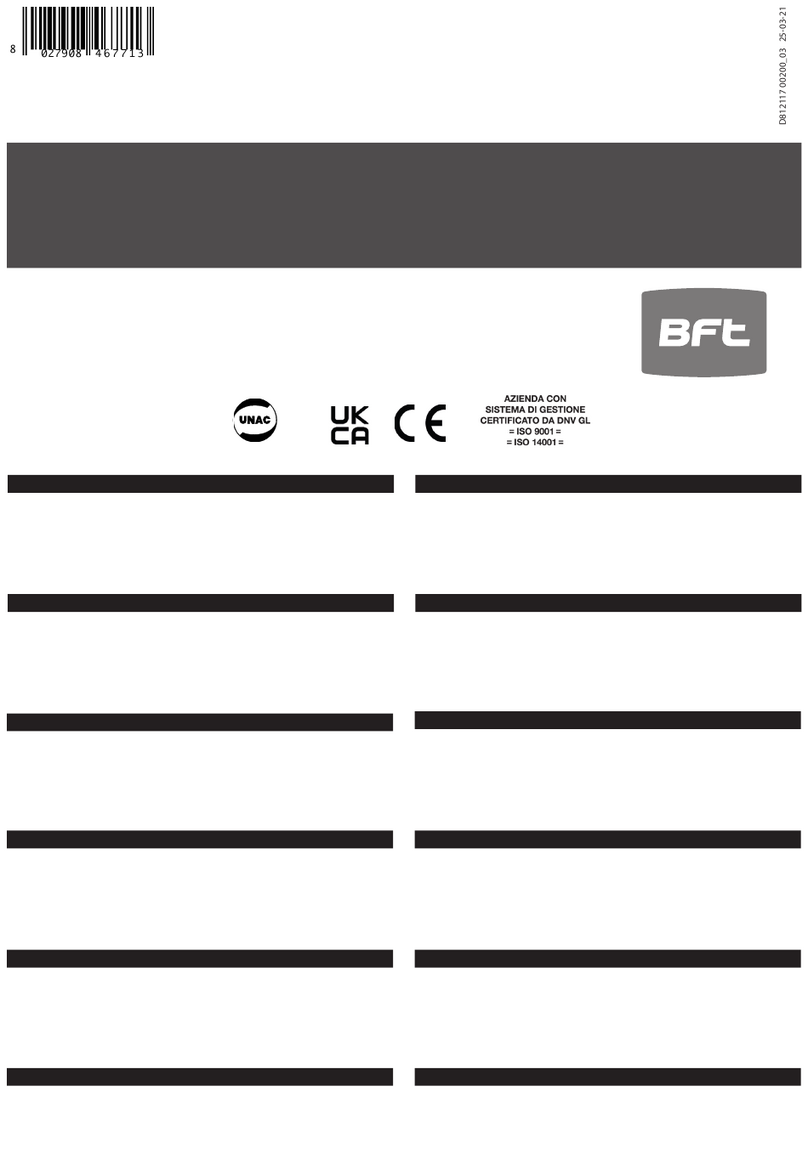
6
• Il presente manuale si rivolge a persone abilitate all'installazione di "apparecchi
utilizzatori di energia elettrica" e richiede una buona conoscenza della tecnica,
esercitata in forma professionale e della normativa vigente.
I materiali usati devono essere certicati e risultare idonei alle condizioni ambientali
di installazione e operazioni di manutenzione devono essere eseguite da personale
qualicato.
• Le apparecchiature qui descritte dovranno essere destinate solo all'uso per il quale
sono state espressamente concepite: "La motorizzazione di cancelli scorrevoli"
no a 3000 kg peso anta.
Attenzione! È assolutamente obbligatoria la presenza delle
battute antideragliamento.
• Questo apparecchio non deve essere utilizzato da persone (bambini compresi) con ri-
dotte capacità siche, sensoriali o mentali, oppure mancanza di esperienza o di conos-
cenza, a meno che esse abbiano potuto beneciare, attraverso l’intermediazione di una
persona responsabile della loro sicurezza, di una sorveglianza o di istruzioni riguardanti
l’utilizzo dell’apparecchio.
• Prima dell’installazione, vericare che la parte guidata sia in buone condizioni, bilanciata
correttamente e che la chiusura e l’apertura avvengano in modo corretto.
• Evitare il rischio di intrappolamento tra la parte guidata e le parti sse circostanti durante
i movimenti di apertura e chiusura.
• Il cavo di alimentazione del motore deve essere in policloroprene conforme alla desig-
nazione 60245 IEC 57.
È responsabilità dell’installatore vericare le seguenti condizioni di sicurezza:
1) L’installazione deveessere sufcientemente lontanadalla stradain modo danon costituire
pericolo per la circolazione.
2) L’operatore deve essere installato all’interno della proprietà ed il cancello non deve aprirsi
verso l’area pubblica.
3) Il cancello motorizzato è principalmente adibito al passaggio di
vetture e non deve essere utilizzata con una porta pedonale.
4) Icomandi(compresiquellidiemergenza)devonoesserepostiinvista,
ad un'altezza compresa tra 1,5 m e 1,8 m, ma non entro il raggio
d’azionedelcancello.Inoltrequelliinstallatiall’esternodevonoessere
protetti da una sicurezza tale da prevenire l’uso non autorizzato.
5) Non permettere ai bambini di giocare con l'apparecchiatura o con
i comandi dell'automazione.
6) È buona norma segnalare l’automazione con targhe di avvertenza (simili a quella in gura)
che devono essere facilmente visibili. Qualora l’automazione sia adibita al solo passaggio
di veicoli dovranno essere poste due targhe di avvertenza di divieto di transito pedonale
(una all’interno, una all’esterno).
7) A monte dell'automazione deve essere installato un dispositivo di sezionamento che
assicuri la disconnessione onnipolare dalla rete di alimentazione, con un a distanza di
apertura dei contatti che consente la disconnessione completa nella condizioni della
sovratensione (categoria III), conformemente alle regole di installazione nazionale.
8) La bontà della connessione di terra dell’apparecchiatura è fondamentale ai ni della
sicurezza elettrica.
9) Per qualsiasi dubbio a riguardo della sicurezza dell’installazione, non procedere ma
rivolgersi al distributore del prodotto.
DESCRIZIONE TECNICA
- Alimentazione generale 230 Vac
-Motore alimentato con tensione max 37 Vdc.
- Carter superiore in materiale plastico antiurto ad alta resistenza.
- Cassa del riduttore in alluminio pressofuso. All'interno opera un sistema di riduzione a
vite senza ne a doppia riduzione con lubricazione a grasso uido permanente.
- Sistema di riduzione irreversibile con sblocco manuale a chiave.
- Programmatore elettronico incorporato completo di parte di potenza, logica di controllo,
carica batterie e sistema radio ricevente.
L’alimentazionevienefornita alla schedadauntrasformatoretoroidaleseparato,alloggiato
nello stesso contenitore e collegato alla scheda tramite Faston.
- Il sistema è dotato di controllo elettronico in frenata, riducendo al minimo gli urti di arresto
dovuti all'inerzia del cancello.
Accessori
106/CRENY - Cremagliera in bra di vetro 20 mm x 30 mm con asole sopra (1 m)
106/CRENY1 - Cremagliera in bra di vetro 20 mm x 30 mm con asole sotto (1 m)
106/SLOAC - Cremagliera in acciaio zincato 20 mm x 22 mm a saldare (2 m)
106/SLOAC2 - Cremagliera in acciaio zincato 12 mm x 30 mm con asole (1 m)
950/NC8K2L - Costa meccanica sensibile, lunghezza da 1,6 a 3,0 m x h 61 mm.
Q
Attenzione! Solo per clienti dell’EU - Marcatura WEEE.
Il simbolo indica che il prodotto alla ne della propria vita utile deve essere raccolto
separatamente dagli altri riuti. L’utente dovrà pertanto conferire l’apparecchiatura
agli idonei centri di raccolta differenziata dei riuti elettronici ed elettrici, oppure
riconsegnarla al rivenditore al momento dell’acquisto di una nuova apparecchiatura
di tipo equivalente, in ragione di uno a uno.
L’adeguata raccolta differenziata per l’avvio al riciclaggio, al trattamento e allo smaltimento
ambientalmente compatibile contribuisce ad evitare possibili effetti negativi sull’ambiente e
sulla salute e favorisce il riciclo dei materiali. Lo smaltimento abusivo del prodotto da parte del
detentore comporta l’applicazione delle sanzioni amministrative previste dalla normativa vigente
nello Stato Comunitario di appartenenza.
Durante la manovra si deve controllare il movimento e azionare il dispositivo di arresto
immediato (STOP) in caso di pericolo.
Attenzione! Pericolo di Intarppolamento. Nell’uso del dispositivo si consiglia di aspettare
la completa apertura del cancello prima di attraversarlo e di prestare la massima attenzione
al pericolo di intrappolamento tra cremagliera e le parti sse del installazione.
In caso di mancanza di energia elettrica e con la batteria scarica il cancello può essere
sbloccato manualmente utilizzando l'apposita chiave di sblocco in dotazione (vedi sblocco
manuale g. 8).
Manutenzione periodica
Prima di eseguire qualsiasi operazione di pulizia o di manutenzione, disinserire l'appa-
recchiatura dalla rete di alimentazione elettrica, staccare l'alimentazione del motore e
scollegare le batterie.
Controllare periodicamente lo stato di usura dei perni ed eventualmente ingrassare le parti
in moto (perni, cremagliera ecc), usando lubricanti che mantengano uguali caratteristiche
di attrito nel tempo e adatti a funzionare tra -20 e + 70°C.
Le eventuali riparazioni devono essere eseguite da personale specializzato usando materiali
originali e certicati.
L'uso dell'automazione non è idoneo all'azionamento in continuo, bensì deve essere
contenuto al 70%.
Prima di procedere all'esecuzione dell'impianto vericare che la struttura da automatizzare sia in
perfetta efcienza nelle sue parti sse e mobili e realizzata in conformità alla normativa vigente.
A tal ne accertarsi che:
- La supercie dell’anta scorrevole "A" sia liscia e senza sporgenze, no all’altezza di 2.5 m dal
suolo. Possono intendersi liscie anche sporgenze dalla supercie no a 3 mm purché con bordi
arrotondati. Se la supercie dell’anta non è liscia, tutta la sua altezza, no al limite di 2.5 m dal
suolo, dovrà essere protetta con i seguenti dispositivi:
a) fotocellule
b) costa sensibile
- lo spazio "B" tra parti fisse e parti scorrevoli non deve essere maggiore di 15 mm.
- la guida di scorrimento "C", preferibilmente di sezione tonda, deve essere ssata al suolo in
modo stabile e indeformabile, completamente esposta e priva di imperfezioni che possano
ostacolare il movimento del cancello.
- a cancello chiuso deve restare uno spazio libero "D", per tutta l’altezza della parte anteriore
del cancello, di almeno 50 mm mentre la battuta meccanica "E" di ne corsa in chiusura deve
essere posta sulla parte superiore del cancello.
- lo spazio libero "D" può essere ricoperto da un elemento elastico deformabile "F" o meglio da
una costa di sicurezza.
- se durante il movimento di apertura, il cancello scorre vicino ad una cancellata "G" ad elementi
verticali o con luci libere provvedere all’installazione di una protezione adeguata secondo il
caso:
1. Distanza "H" maggiore di 500 mm: nessuna protezione;
2. Distanza "H" compresa tra 500 e 300 mm: applicazione di una rete "I" o di un traforato
metallico "L" avente aperture che non permettano il passaggio di una sfera "M" del diametro
di 25 mm;
3. Distanza "H" minore di 300 mm: applicazione di una rete "I" o di un traforato metallico "L"
aventi aperture che non permettano il passaggio di una sfera "M" del diametro di 12 mm.
I li delle reti "I" non devono avere sezione minore di 2,5 mm2e i traforati metallici "L" non
devono avere spessore minore di 1,2 mm. Oltre il limite di 2,5 m dal suolo per il tratto "P"
di scorrimento del cancello tali protezioni non sono necessarie.
- vericare lo stato di usura di eventuali parti vecchie, consumate del cancello e se necessario
provvedere alla loro sostituzione e lubricazione.
- vericare la messa in bolla "N" della guida.
- i pattini o rulli di guida superiori "O" devono presentare un giusto gioco allo scorrimento dell’anta
e in nessun caso ostacolare la sua corsa.
- verificare l’esistenza, assolutamente necessaria, di una battuta di arresto "Q" mecca-
nico in apertura in corrispondenza della massima corsa "P", tale da garantire la stabi-
lità del cancello e quindi di evitare il pericolo di sgancio dai rulli di guida superiori "O".
Attenzione! È comunque cura dell’installatore vericare i punti critici, di pericolo, e prendere
gli opportuni provvedimenti ai ni della sicurezza e dell’incolumità personale (analisi dei rischi).
ATTENZIONE! IMPORTANTI ISTRUZIONI DI SICUREZZA
CONSIDERAZIONI GENERALI DI SICUREZZA
VERIFICHE PRELIMINARI (fig. 1, pag. 2)
APERTURA AUTOMATICA
NON AVVICINARSI
NON PERMETTERE A BAMBINI O AD
ANIMALI DOMESTICI DI SOSTARE NEL
RAGGIO D'AZIONE DEL CANCELLO
ATTENZIONE
È IMPORTANTE PER LA SICUREZZA DELLE PERSONE SEGUIRE QUESTE ISTRUZIONI: LEGGERE ATTENTAMENTE LE SEGUENTI AVVERTENZE
PRIMA DI PROCEDERE ALL’INSTALLAZIONE. PRESTARE PARTICOLARE ATTENZIONE A TUTTE LE SEGNALAZIONI DISPOSTE NEL TESTO DI
QUESTO LIBRETTO D'ISTRUZIONI ORIGINALE. IL MANCATO RISPETTO DI QUESTE POTREBBE COMPROMETTERE IL BUON FUNZIONAMENTO
DEL SISTEMA E CREARE SITUAZIONI DI PERICOLO GRAVE PER L'OPERATORE E GLI UTILIZZATORI DEL SISTEMA STESSO. CONSERVARE QUESTE
ISTRUZIONI PER OGNI FUTURO RIFERIMENTO.
AVVERTENZE PER L'UTENTE
